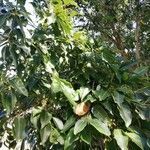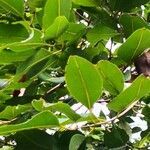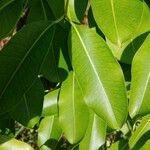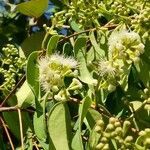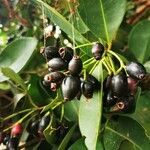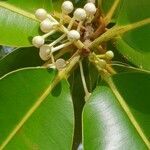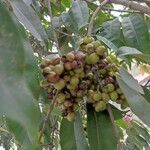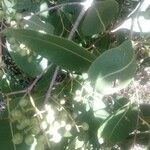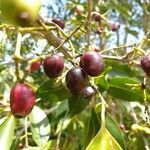Trees, 6-20 m tall. Branchlets grayish white when dry, terete. Petiole 1-2 cm; leaf blade broadly elliptic to narrowly elliptic, 6-12 × 3.5-7 cm, leathery, abaxially slightly pale when dry, adaxially brownish green to blackish brown and slightly glossy when dry, both surfaces with small glands, secondary veins numerous, 1-2 mm apart, and gradually extending into margin, intramarginal veins ca. 1 mm from margin, base broadly cuneate to rarely rounded, apex rounded to obtuse and with a short cusp. Inflorescences axillary on flowering branches or occasionally terminal, paniculate cymes, to 11 cm. Hypanthium obconic or long pyriform, ca. 4 mm or 7-8 mm. Calyx lobes inconspicuous, 0.3-0.7 mm. Petals 4, white or light purple, coherent, ovate and slightly rounded, ca. 2.5 mm. Stamens 3-4 mm. Style as long as stamens. Fruit red to black, ellipsoid to pot-shaped, 1-2 cm, 1-seeded; persistent calyx tube 1-1.5 mm. Fl. Feb-Mar or Apr-May, fr. Jun-Sep.
A medium sized evergreen tree. It grows 10-30 m tall. The stem is erect and branching. The leaves are opposite and smooth. They are shiny, leathery and somewhat oval shaped. The leaves are 4.5-16.5 cm long by 2-8 cm wide. The flowers are pink or nearly white and occur on compound flower arrangements below the leaves. The fruit is oval with dark purple flesh and is green but develops a nearly black skin when ripe. Fruit can be 2.5 cm long or more. The pulp is purplish-white and juicy. They are fleshy and have a large greenish seed. The fruit is edible.
Inflorescence a lateral, lax panicle, mostly borne in the axils of fallen leaves on older stems, very rarely also axillary or terminal.
Receptacle (including pseudopedicel) + calyx c. 0·5 cm. long; calyx + upper receptacle 0·2 cm. long; filaments 0·5–0·6 cm. long.
Leaf-lamina up to 13 x 5 cm., elliptic or oblanceolate-elliptic, apex subacuminate or shortly acuminate, base cuneate.
Fruit up to 2·4 x 2 cm., ellipsoid or subglobose.
Evergreen tree 6–15 m. tall.
Bark rough, dark.
